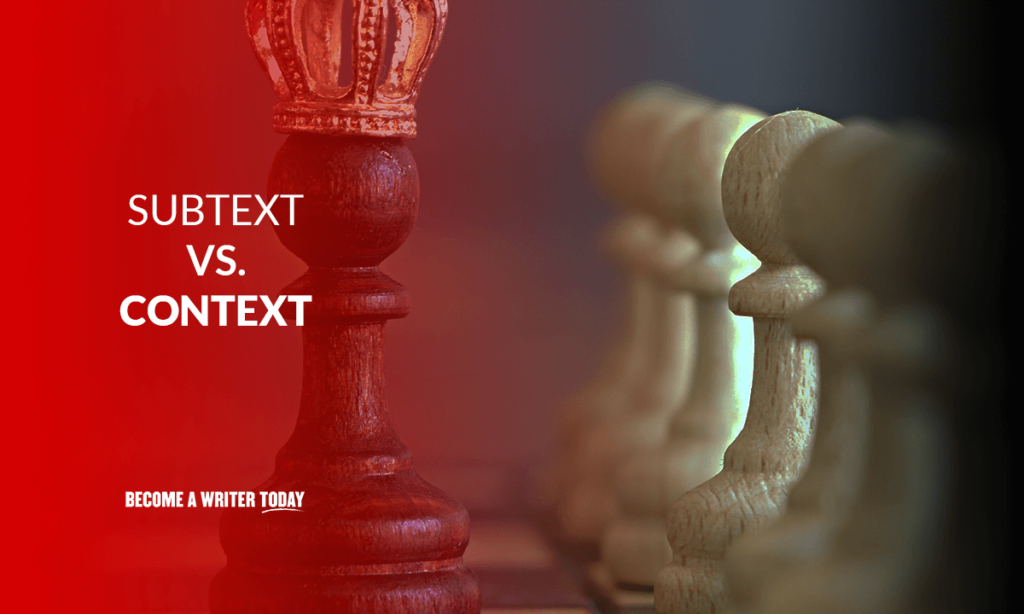Understanding the difference between subtext vs context will make fiction writers stronger.
Fiction stories have many components that make them succeed. While the character development and dialogue between the people in a story are important, they are just one component of a good story. The context of the story and the subtext behind that context is also vital.
If you are going to write fiction, you need to understand how to include context in your works and how to add subtext to make it more meaningful. Yet these two literary components are not precisely the same. Here is a closer look at subtext vs context and how they relate and how they differ.
You may also enjoy our article on the best books on writing fiction.
Contents
What Is Context?

The context speaks of the details of the story. It is the grounding and guiding information that a reader or audience needs to understand the meaning of a text. In fiction writing, context might include things like setting, time of day, names and physical characteristics of the main characters, and the overall story structure.
Context makes a story understandable and accessible. Without it, the reader has too many questions about what is happening and why. Good storytellers learn how to add just enough context to keep the meaning in the story without giving away too many details.
Common Types of Context
Writers have several types of context they can use in a story. These include:
- Authorial context: This type of context, also known as biographical context, shows how the author or narrator’s real-life connects to the story. For example, the author may have lived in the town where the story takes place, drawing their knowledge from that part of their life.
- Historical context: Historical context refers to the history and society of the story’s time frame. This context influences what the characters think and do, as well as the technology that is available to them.
- Philosophical context: Humanity has historically addressed many questions of the world, like where we came from and the meaning of life. These questions can be part of the philosophical context of a story.
- Literary context: The genre of the story can impact its literary context. A tale with traits of modernism will read differently than one with traits of romanticism.
Examples of Context
The context shows up in literature and is usually pretty easy to identify. Here are some well-known examples.
The Handmaid’s Tale
In The Handmaid’s Tale by Margaret Atwood, the story’s context is vital. Its dystopian society significantly impacts the actions and thoughts of the characters and even the situation each character finds themselves in. One quote adds context to what is happening in this world:
Ordinary, said Aunt Lydia, is what you are used to. This may not seem ordinary to you now, but after a time, it will.
In this quote, Aunt Lydia shows how things, even terrible things like oppression and murder, can become ordinary if you do them enough, which becomes a key concept throughout the book.
A Tale of Two Cities
In the Charles Dickens novel A Tale of Two Cities, the opening paragraph lends context to the book:
It was the best of times, it was the worst of times, it was the age of wisdom, it was the age of foolishness.
The quote continues, but it showcases the dichotomy of the era of the French Revolution.
What is Subtext?
The subtext is the meaning that happens “between the lines” of the piece you are reading. The subtext helps the reader better interpret the piece they are reading. It is not explicitly explained, but it allows the reader to pick up on cues that tell these additional details.
Another way to think of subtext is “Show, don’t tell.” Characters can say anything they want in a story, but their subtext, underlying thoughts, and actions show their true motivations.
The subtext is vital to telling more about a story. Without subtext, your story will fall flat. It will lack engagement and the undercurrents that help the reader become fully immersed and engaged.
Common Types of Subtext
Subtext can show up in a story in several ways. Some of these include:
- Privilege subtext: By revealing something to the reader that the main characters do not know themselves, you give the reader privileged information that fully draws them into the story. Writers and filmmakers often use inner dialogue or flashbacks into the characters’ backstory to do this. The reader can draw their own conclusions about the characters’ motivations with these teasers before the characters do.
- Questioning subtext: This type of subtext creates questions in the reader’s mind by revealing just enough information to spark that curiosity but not enough to give away the full context. Curiosity keeps the reader engaged with the story.
- Revelation subtext: This type of subtext reveals something slowly through teasers as the book unfolds. This technique usually builds to a big reveal, such as when Gatsby piles up his expensive shirts to reveal his wealth to Daisy’s long-lost love in The Great Gatsby.
- Body language subtext: This type of subtext is less complex, but a writer can use body language to convey a meaning different from what the character says or does.
- Linguistics subtext: The tone of voice can significantly affect the subtext of a plot. Someone can say “I love you” in a biting tone and mean something completely different from the actual meaning of the words.
Common Results of Subtext

The subtext of a work creates a number of literary devices and tools that make a story more engaging. Through the subtext, a writer can create:
- Unreliable narrators: Narrators are usually know-all characters until the subtext reveals an ulterior motive or character flaw that skewed the narrator’s view.
- Successful mysteries: When solving a mystery, the detective often follows clues in the subtext to find the successful resolution.
- Humor: Subtext can add humor to the context of the story.
Examples of Subtext
Subtext examples are found throughout the literature. Studying these samples will help you understand the difference between subtext vs context.
The Great Gatsby
In the same scene mentioned above of The Great Gatsby, when the pile of shirts Gatsby creates starts to grow, Daisy begins to cry. She then indicates she is sad because she has never seen such shirts before.
“They’re such beautiful shirts,” she sobbed, her voice muffled in the thick folds. “It makes me sad because I’ve never seen such—such beautiful shirts before.”
Is Daisy really sad about the shirts? The reader knows the characters well enough by now to know that the answer is no. Instead, she is sad because she didn’t stay with Gatsby, even though she loved him, because of his seeming lack of wealth.
Annie Hall
In the movie Annie Hall, filmmaker Woody Allen uses subtext beautifully. When the main characters, Alvie and Annie, meet for the first time, they discuss photography. While they chat, the audience reads subtitles at the bottom of the screen.
These subtitles add subtext by showing the inner dialogue of the two characters. We can see that they are, in fact, becoming interested in one another beyond the surface discussion.
A Final Word on Subtext vs Context
Subtext and context are both important to the meaning and feel of a story. The context tells the reader details about the character, their motivations, and the story’s setting. The subtext gives additional depth to the story.
To have a well-written story, you need to have both. Learn to weave subtext into your writing while being clear with the context, and the meaning of the story will be something the reader can quickly grasp.
FAQs About Subtext vs Context
What is the difference between subtext and context?
Context is the precise details of a story that make the reader understand what is going on. The subtext is a more subtle factor that hints at what may motivate the characters and what is happening behind the scenes to make the story progress.
Do all stories need subtext?
You can write a story without subtext. However, it will not engage the reader and will feel dry. To have a rich, engaging story, you need subtext.
If you are interested in the use of humor, irony, and exaggeration in your writing, read our article on types of satire in fiction.